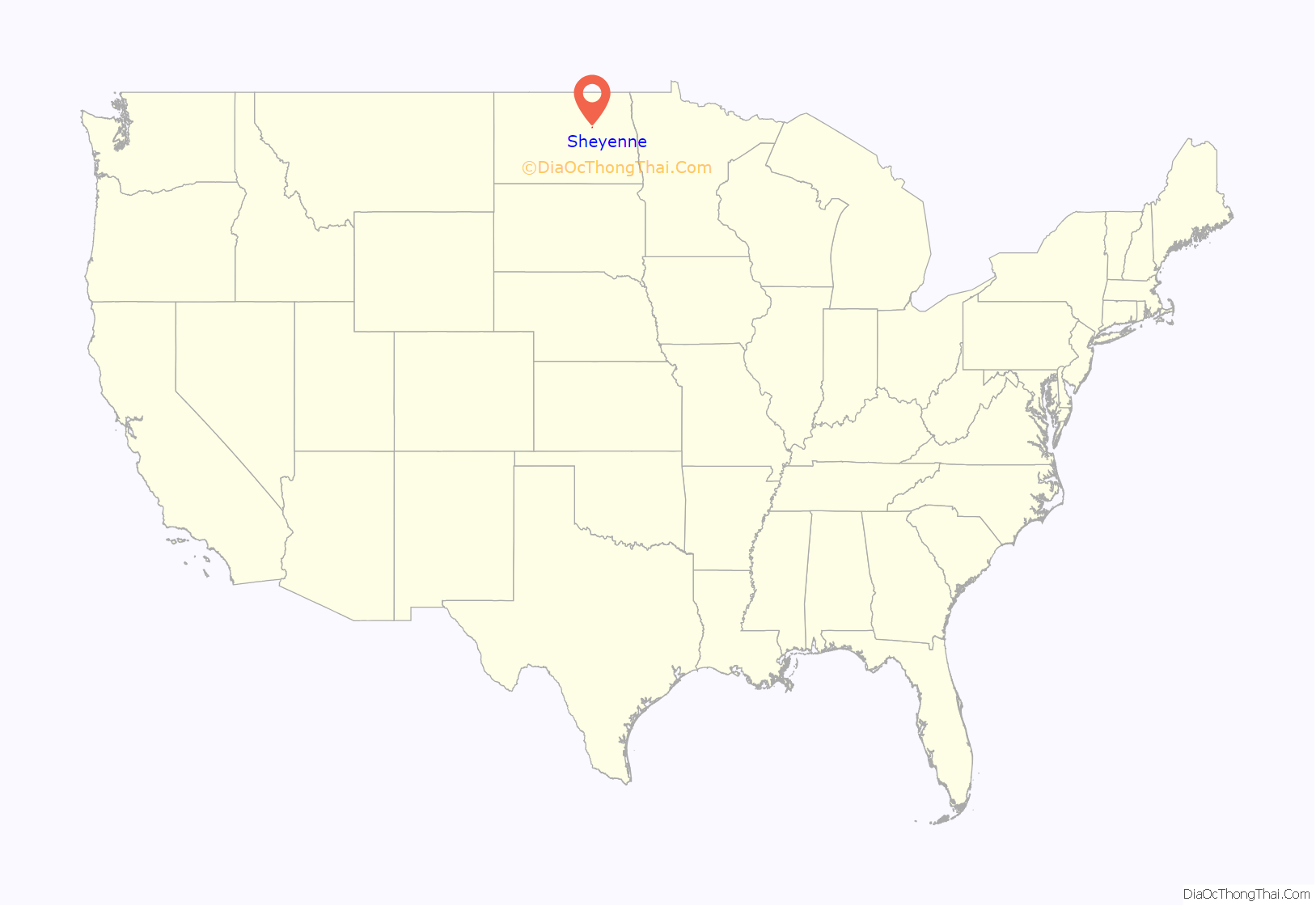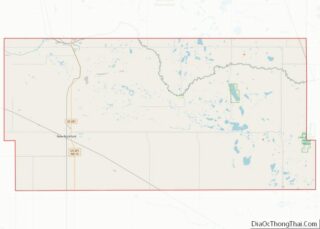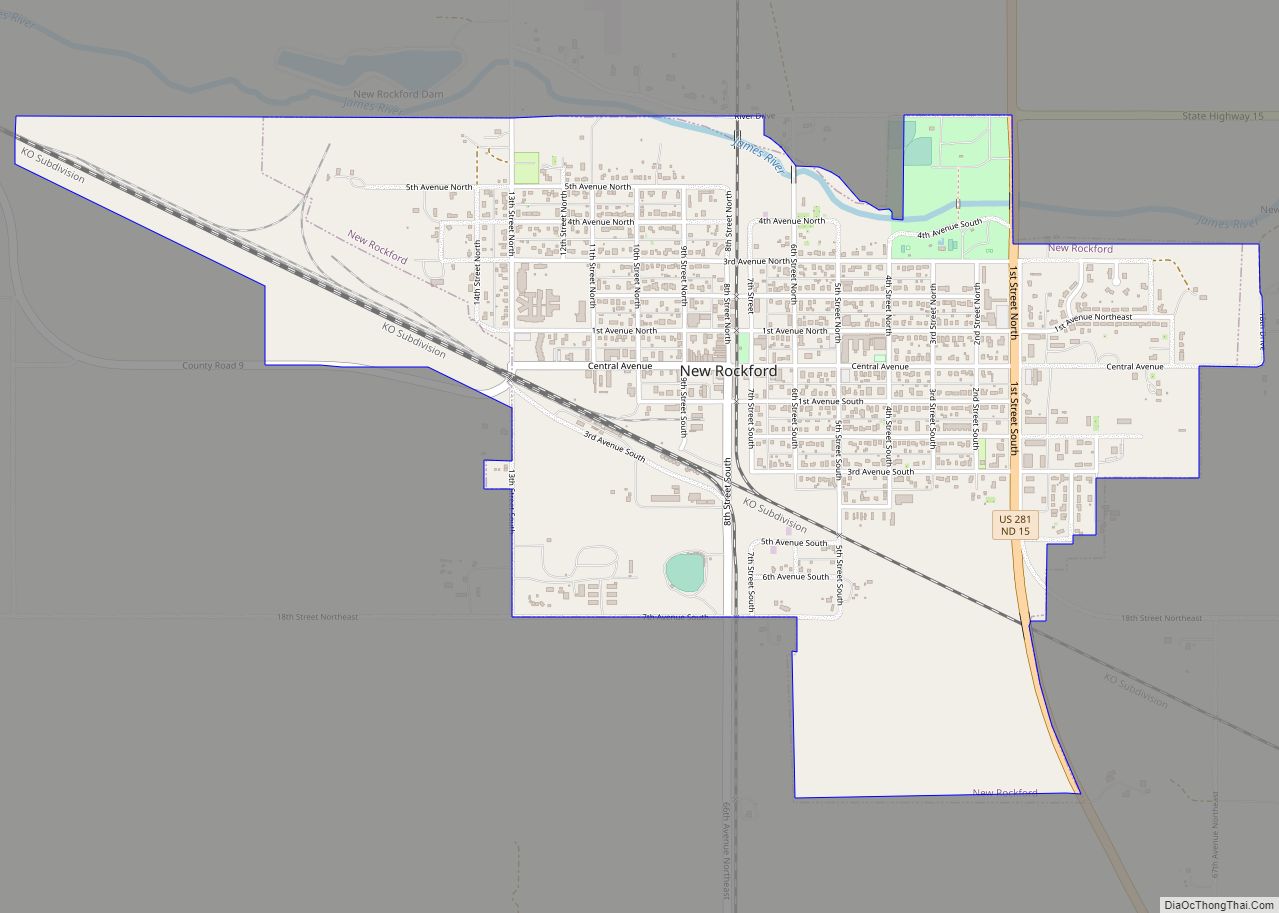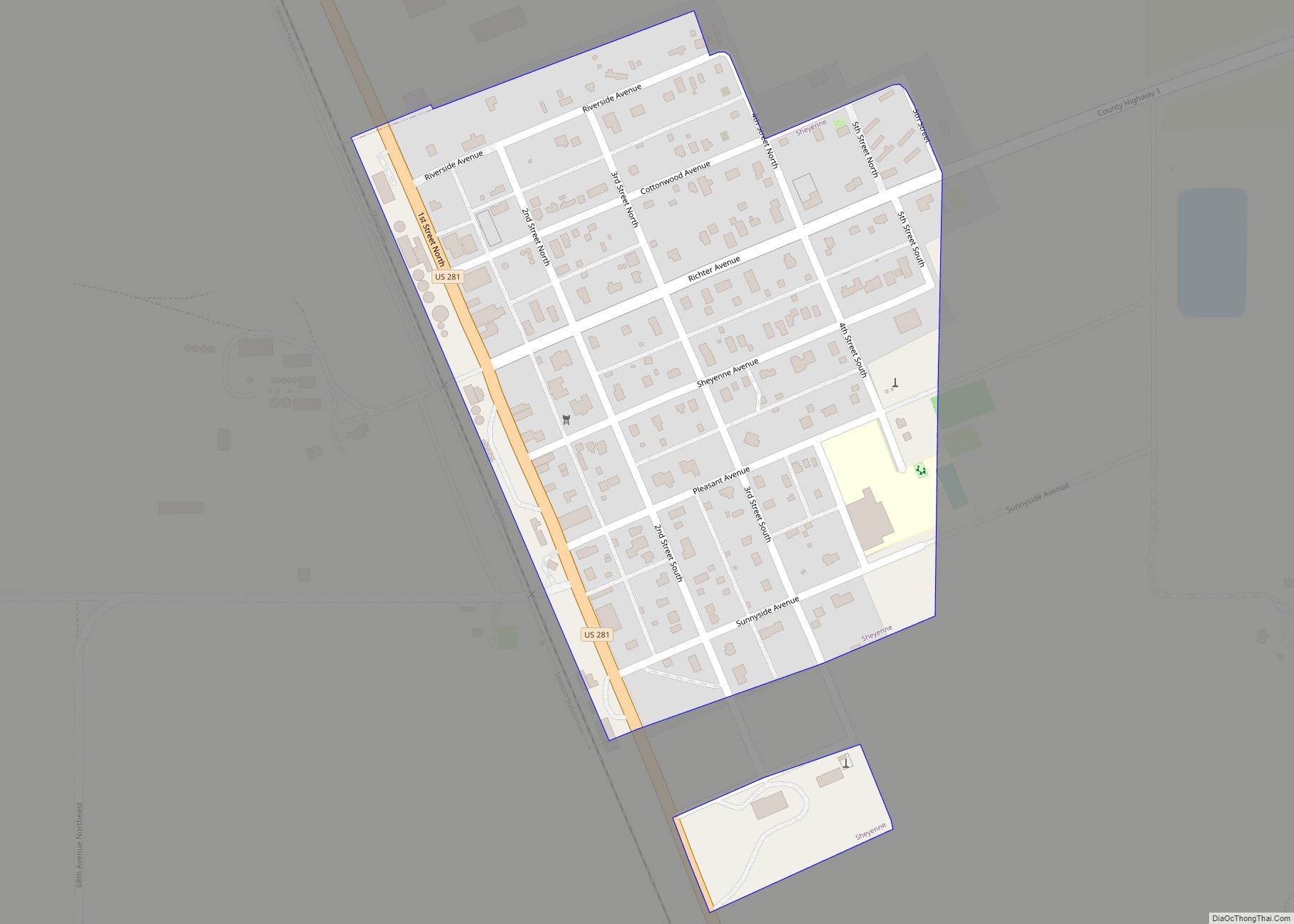Sheyenne is a city in Eddy County, North Dakota, United States. The population was 186 at the 2020 census. Sheyenne was founded in 1883. Located in the city are a U.S. post office, a senior citizens’ center, and a fire department. A community center and the Log Cabin Museum are located on Main Street (U.S. Route 281). Businesses in the city include a farm implements dealer, a gas station, a hair salon, a taxidermy shop, Open Season Lodge & Event Center, and a bar. On the east end of town there is a park with campsites located on Warsing Dam. Sheyenne is also home to two Lutheran churches: Grace Lutheran and First Lutheran.
| Name: | Sheyenne city |
|---|---|
| LSAD Code: | 25 |
| LSAD Description: | city (suffix) |
| State: | North Dakota |
| County: | Eddy County |
| Founded: | 1883 |
| Elevation: | 1,480 ft (451 m) |
| Total Area: | 0.15 sq mi (0.39 km²) |
| Land Area: | 0.15 sq mi (0.39 km²) |
| Water Area: | 0.00 sq mi (0.00 km²) |
| Total Population: | 186 |
| Population Density: | 1,240.00/sq mi (479.22/km²) |
| ZIP code: | 58374 |
| Area code: | 701 |
| FIPS code: | 3872580 |
| GNISfeature ID: | 1032055 |
Online Interactive Map
Click on ![]() to view map in "full screen" mode.
to view map in "full screen" mode.
Sheyenne location map. Where is Sheyenne city?
History
The name “Sheyenne” is derived from the nearby Sheyenne River which was named after the Cheyenne Indians. The first explorers in the area misspelled the name, thus changing the “C” to an “S”. Herds of bison once roamed the prairies near the town of Sheyenne. The Sioux tribe were the final Native American tribe to move towards the area. The first white settlers came via the Northern Pacific Railroad Company. The earliest mention of the settlement came through the Grand Forks, North Dakota-based paper, Normadden. The Norwegian language paper mentioned the building of the section house in 1885 and the setting up of six tents in order to establish a townsite and a depot. The main track was laid on November 28, 1884. The railroad began operation to Sheyenne on August 6, 1885.
The main townsite of Sheyenne was obtained by Clarence E. Bennett in 1885, but later came under the jurisdiction of J. W. Richter, who dedicated the townsite in 1892. The first crops grown in the area were common vegetables and as much wheat that the land could take. The main source of meat was hunting on the abundant plains, and the other source was in the Sheyenne River. People streamed into the community from all parts of the United States and Europe. Most European settlers came from Scandinavia and Germany. Businesses flourished off railroad workers and farmers.
Fire of 1894
On December 7, 1894 at approximately 4:30 A.M., a fire began in the George Williams Livery Barn and spread to other businesses on Main Street. Williams’ billiard room and soft drink shop were the next to be consumed. The blaze then spread to the Westerlund Hotel and the Hugh Peoples General Store. The post office also caught fire, but N.U. Hanson saved all the mail that was on-hand. The fire was determined to be incendiary in origin. George Williams closed his stables at 2:00 A.M. and locked the door. When firemen arrived at the scene, they realized that the door was open, and later it was determined that the fire began in the unused box stall. In the wake of the disaster, the merchants rebuilt and continued serving the Sheyenne area.
Sheyenne was home to C.G. Hayes, a farmer by trade who lived South of the townsite. Hayes became a soldier and was stationed at Fort Totten. He became a scout during the Indian Wars in the Northwest. After that, he served under the Seventh Cavalry banner, and was one of the messengers who sent for reinforcements after The Battle of the Little Bighorn. In 1897, Sheyenne began publishing its first newspaper, The Sheyenne Star.
The 1900s
Settlers and immigrants continued to swarm to the area as they came via boxcar and train. They also arrived by cars and wagons. Businesses in Sheyenne included numerous department stores, meat markets, livery stables, a depot, a blacksmith shop operated by Hans Stenberg, Odegaard’s Shop, a feed mill, and land companies. Sheyenne had several elevators that stored different local goods. There was a Ford dealership, numerous service stations, numerous pharmacies, cafes, a hotel, a public bath, and a lumberyard. A cream station, an opera house, and a variety store also existed in Sheyenne at one time. Many banks have come and gone over the brief period of Sheyenne’s existence, including the Farmers’ State Bank.
Creamery Day Celebration 1913
The opening of the creamery in Sheyenne was the largest event in Sheyenne history in terms of turnout. The event was created to celebrate the opening of Sheyenne’s creamery on June 28, 1913. Over 2000 people were present at the event. The festivities began with a parade that covered 22 blocks that included the Fort Totten Indian Band, the Boy Scouts, and numerous merchants’ floats. The parade ended at the creamery, where everyone was served free ice cream and buttermilk. Over 1900 ice cream cones were served. The climax of the day was when Professor G.F. Martin of North Dakota Agricultural College, now North Dakota State University, spoke about the importance of dairy. A baseball game was then played between Sheyenne and New Rockford, and at 9:00 a grand ball was held at the opera house.
1914–present
The Sheyenne area progressed through World War I and the 1918 influenza epidemic. A shock to the area came in the 1930s with the Great Depression, when the main industry of the area, agriculture, was threatened severely. Poor crop prices influenced Sheyenne’s economy and the WPA was crucial to the life of Sheyenne. It created a park on the south side of Sheyenne that is now owned by the VFW, it restored the town jail, and its workers built Warsing Dam on the outskirts of the city. In the 1940s numerous residents fought in World War II, and the Sheyenne Star ceased publication. In 1955, the second irrigation experimental farm in North Dakota was planned on the land of Bruce Larson, while a major concern of the late 1950s was the high nitrate condition in the wells of Sheyenne. The problem was solved by the Northern Pacific Railway Company donating their well to the City of Sheyenne. A major event in the 1960s was the opening of the Tastee-Freez, a fast food and ice cream restaurant, in the building previously occupied by the city’s fire department. Community betterment was the highlight of the 1970s in Sheyenne, when projects such as street paving, tennis courts, townhouses, a museum, and main street revitalization were finished. In 1977 Sheyenne won the North Dakota Community Betterment Award for its work on its projects.
Sheyenne celebrated its 125th with a demo-derby, BBQ dinner, parade, school reunion, fireworks, and a children’s theater production, put on by the S.T.A.R.S.
Sheyenne Road Map
Sheyenne city Satellite Map
Geography
According to the United States Census Bureau, the city has a total area of 0.16 square miles (0.41 km), all land.
See also
Map of North Dakota State and its subdivision:- Adams
- Barnes
- Benson
- Billings
- Bottineau
- Bowman
- Burke
- Burleigh
- Cass
- Cavalier
- Dickey
- Divide
- Dunn
- Eddy
- Emmons
- Foster
- Golden Valley
- Grand Forks
- Grant
- Griggs
- Hettinger
- Kidder
- Lamoure
- Logan
- McHenry
- McIntosh
- McKenzie
- McLean
- Mercer
- Morton
- Mountrail
- Nelson
- Oliver
- Pembina
- Pierce
- Ramsey
- Ransom
- Renville
- Richland
- Rolette
- Sargent
- Sheridan
- Sioux
- Slope
- Stark
- Steele
- Stutsman
- Towner
- Traill
- Walsh
- Ward
- Wells
- Williams
- Alabama
- Alaska
- Arizona
- Arkansas
- California
- Colorado
- Connecticut
- Delaware
- District of Columbia
- Florida
- Georgia
- Hawaii
- Idaho
- Illinois
- Indiana
- Iowa
- Kansas
- Kentucky
- Louisiana
- Maine
- Maryland
- Massachusetts
- Michigan
- Minnesota
- Mississippi
- Missouri
- Montana
- Nebraska
- Nevada
- New Hampshire
- New Jersey
- New Mexico
- New York
- North Carolina
- North Dakota
- Ohio
- Oklahoma
- Oregon
- Pennsylvania
- Rhode Island
- South Carolina
- South Dakota
- Tennessee
- Texas
- Utah
- Vermont
- Virginia
- Washington
- West Virginia
- Wisconsin
- Wyoming






